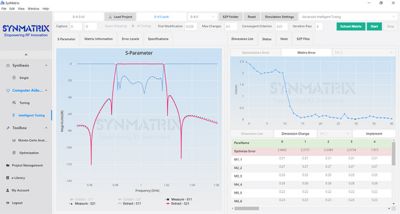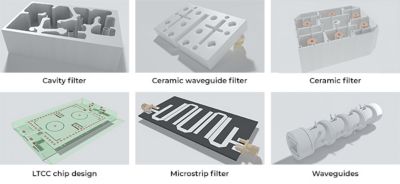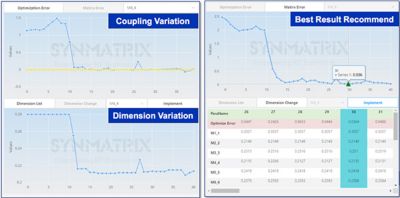-
United States -
United Kingdom -
India -
France -
Deutschland -
Italia -
日本 -
대한민국 -
中国 -
台灣
-
Ansys stellt Studierenden auf dem Weg zum Erfolg die Simulationssoftware kostenlos zur Verfügung.
-
Ansys stellt Studierenden auf dem Weg zum Erfolg die Simulationssoftware kostenlos zur Verfügung.
-
Ansys stellt Studierenden auf dem Weg zum Erfolg die Simulationssoftware kostenlos zur Verfügung.
-
Kontakt -
Karriere -
Studierende und Akademiker*innen -
Für die Vereinigten Staaten und Kanada
+1 844,462 6797
ANSYS BLOG
May 6, 2020
How to Design 5G and mm-Wave Filters Using AI-Optimized Tuning
The demand for 5G applications increases the need for radio frequency (RF) and microwave filter components in the mm-Wave frequency bands.
The SynMatrix online interface with the AI-optimized tuning panel.
“5G applications present some unique challenges to mm-Wave and 5G passive components,” said Diamond Liu, product manager of SynMatrix. “Fabrication capability limitations make it very difficult for designers to produce components that are manufactured easily. Some of the major obstacles include the extra cost for pre-sampling and time-consuming tuning and debug activities.”
Despite the design challenges to produce these products, there are options for Ansys HFSS users to overcome them. SynMatrix, an Ansys software partner, offers a RF and microwave design platform for 5G and mm-Wave components. It also supports a complete line of structures including cavity, waveguide, coaxial, low temperature co-fired ceramic (LTCC) chip, ceramic and microstrips.
Liu added, “With SynMatrix’s comprehensive design platform, designers can accurately produce the required RF performance and simulation. This is faster, easier and cost-effective.”
Structures supported by SynMatrix
HFSS users can import their design parameters into SynMatrix which enables them to leverage a comprehensive set of tools that accelerate the design process.
After importing the data, users can utilize the platform to auto-tune and edit the parameters necessary to meet the desired RF design output. The simplified workflow and toolset helps them estimate and fine-tune the design long before a physical prototype is built.
Edit HFSS parameters directly within the SynMatrix interface (left). HFSS design variables automatically import into SynMatrix (middle). Once the simulation is complete, the corresponding S2P file will be imported into the system.
Edit HFSS parameters directly within the SynMatrix interface (left). HFSS design variables automatically import into SynMatrix (middle). Once the simulation is complete, the corresponding S2P file will be imported into the system.
How Ansys HFSS Users Benefit from the SynMatrix Design Platform
The SynMatrix design platform offers a list of comprehensive tools that include:
- Coupling matrix synthesis
- Dispersive effect control
- Matrix optimization and Monte-Carlo analysis
- Peak power handling
From a simulation point of view, users will benefit from:
- Computer-aided tuning and diagnostic features
- Advanced coupling matrix extraction
- Multiport tuning and deep optimization
Dispersive effect control during matrix extraction
One of the most exciting features available for HFSS users is SynMatrix’s AI-optimized tuning function. Thanks to this tool, users will benefit from:
- An AI-optimized system that converges to a solution automatically
- Advanced space mapping and tuning error features
- An integrated HFSS workflow with progress monitoring features
There are a number of RF and microwave filter design tool alternatives, but few are as comprehensive as the design workflow offered with SynMatrix and HFSS.















